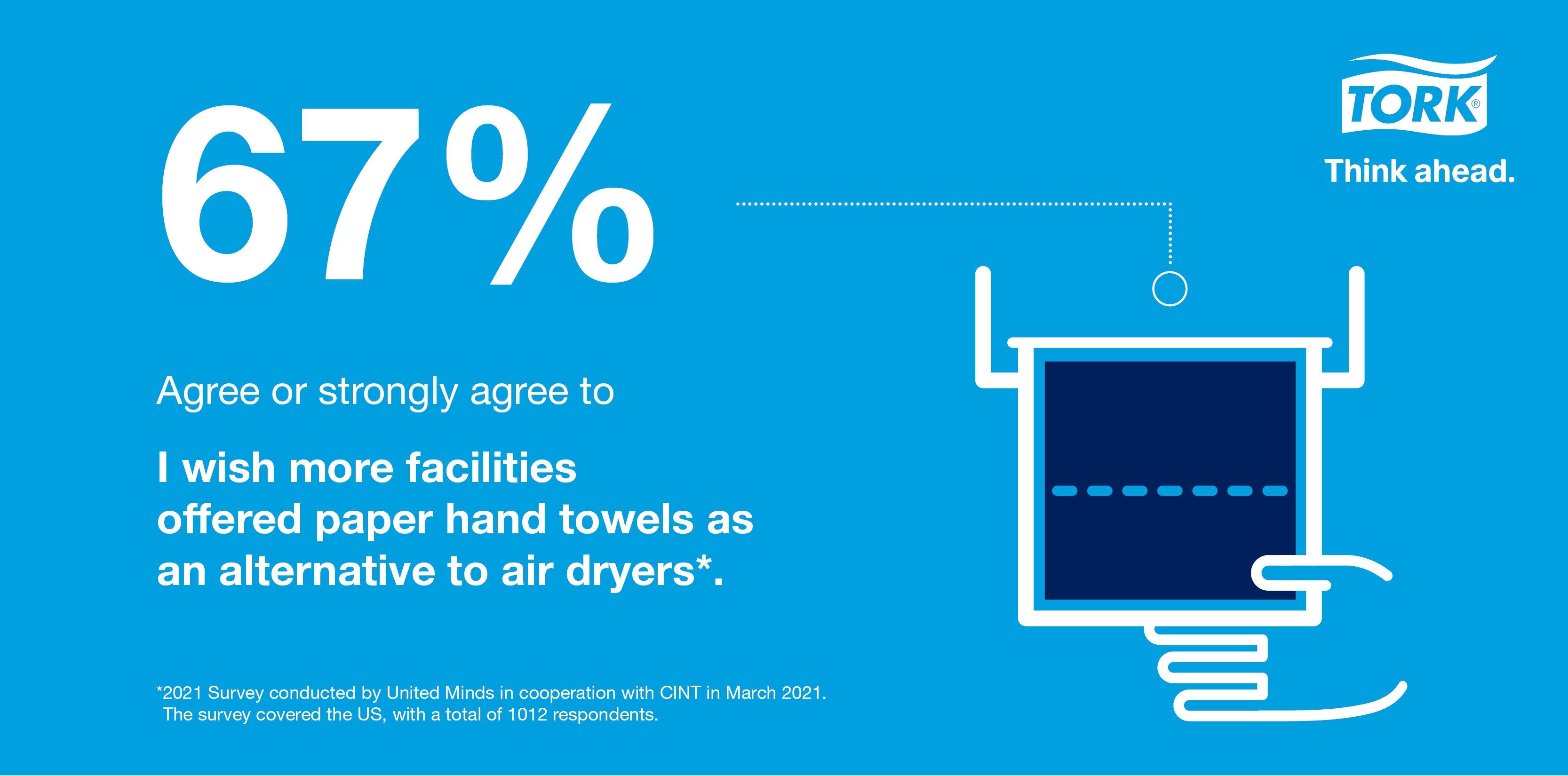Facility managers today are faced with the dual challenges of reducing the risk of pathogen transmission and meeting the heightened expectations of an increasingly hygiene-conscious public. As a result, they are under intense pressure to choose the right equipment and tools for their offices.
Restrooms, due to their small size, high traffic, and often poor ventilation, are a particular flashpoint for cleanliness concerns today. Approximately 73% of people say they feel more unsafe using facilities with unhygienic public restrooms due to COVID-19.1
Sometimes there’s a simple solution: changing out jet air dryers for paper towels. This change can do a lot to reduce the spread of germs through the air and on surfaces in office restrooms and meet users’ preferences.
The dirt on drying
While hygiene education tends to focus on proper handwashing technique, hand drying is also an essential step in the process. Clean, dry hands are a crucial factor in reducing the spread of infectious germs and pathogens in restrooms and throughout the rest of the office.
Although air dryers have been accepted as just another way to dry your hands in the past, users are now starting to question their options. Jet air dryers can spread up to 10 times more bacteria than paper towels.2 Studies show they disperse more bacteria into the air and produce more airborne droplets.3 Plus, jet air dryers can only serve one person at a time—resulting in lines and waits to use them and potentially hindering social distancing efforts. Finally, 62% of users say they stop using dryers before their hands are completely dry because they take too long.4
The science agrees: paper towels are more hygienic
Besides reducing the spread of bacteria and other microbes through the air, the mechanical action of rubbing paper towels on hands is better at removing various types of pathogens. Using warm air dryers and jet air dryers has been shown to be less effective than paper towels in reducing bacteria on the fingertips.5 Also, using paper towels resulted in lower rates of virus contamination on hands and clothing compared to using a jet air dryer.6

It’s also important to know that people prefer paper towels. 67% of people wish more facilities offered paper hand towels as an alternative to air dryers.4 Besides drying hands, paper hand towels offer multiple uses. They protect hands from picking up microbes when touching sink and door handles as well as other shared surfaces. They can be used to wipe mouths and noses after coughing or sneezing. Finally, they are handy for other tasks such as diaper cleanup and cosmetic touch-ups.
Hand hygiene: the first line of defense against communicable diseases
The new increased standards of hygiene we are experiencing as a result of the pandemic are probably here to stay, and that’s a good thing. Proper handwashing and healthy hygiene habits are important methods of limiting the spread of all kinds of communicable diseases and infections. Having the right tools in place—including paper hand towels in restrooms—help ensure people feel safer and more confident in public spaces.
This environment of elevated hygiene awareness requires a new level of diligence and smarter choices from facility managers. Tork® is committed to helping people feel safer in the workplace and other public spaces with products designed to maintain the increased standards of hygiene that society demands, including high-capacity single-use paper towel dispensers. Visit Torkusa.com/SaferChoice to learn more about how to make better decisions for the people who depend on you.
Sources
1 2021 Survey conducted by PRS Invivo in March 2021. The survey covered in the US and Germany, with 100 respondents in each market.
2 Best et al., J Hosp Infection, 2014
3 Margas E. et al., J Applied Microbiol, 2013
4 2021 survey conducted by United Minds in cooperation with CINT in March 2021.The survey covered the U.S., with a total of 1012 respondents.
5 Snelling A.M., 2010
6 Moura, I., Ewin, D., & Wilcox, M., Infection Control & Hospital Epidemiology, 2021
